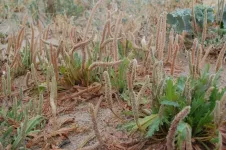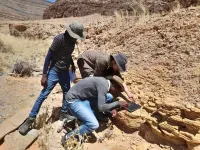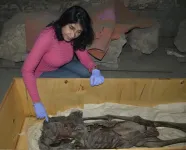(Press-News.org) Two of the planet’s more pressing environmental stressors have the potential to alter the growth and reproductive output of plants found right along the world’s coastlines, a new study suggests.
The research, published in the journal Environmental Pollution, is one of the first to examine the combined effects of seawater flooding and microplastic pollution on coastal plants.
It showed that both stressors had some effects on the species tested, with microplastics impacting the plants’ reproduction while flooding caused greater tissue death.
However, being exposed to both microplastics and flooding together – a threat likely to increase as a result of climate change and plastic use – had a more pronounced impact on their resource allocation.
This in turn led to the plants exhibiting altered growth and experiencing a short-term suppression in their photosynthetic efficiency, responses affect the plants’ ability to capture water, nutrients and sunlight, and contribute to ecosystem wellbeing.
The study was led by experts in plastic pollution and plant biology from the University of Plymouth’s School of Biological and Marine Sciences and International Marine Litter Research Unit.
They say it signposts the potential for microplastics to present an elevated risk when in combination with additional stressors like seawater flooding and that, as a result, establishing the threats presented by multiple co-occurring stressors on ecosystem resilience is a priority.
Dr Winnie Courtene-Jones, the study’s lead author, said: “This research highlights the potential for microplastics, composed of conventional and biodegradable plastic, to detrimentally affect plant functioning. Moreso, it indicates that the effect of microplastics can be magnified by other environmental factors such as rising sea levels and coastal flooding. Studies such as this help us appreciate the potential harm posed by microplastics to a range of organisms, and ecosystem resilience generally.”
The study was carried out as part of BIO-PLASTIC-RISK, a £2.6million project led by the University and supported by the Natural Environment Research Council.
It focused on buck's horn plantain (Plantago coronopus), a low-growing perennial native to Europe, Asia and North Africa – but also found in the United States, Australia, and New Zealand – which commonly grows in sand dune and beach shingle coastal habitats.
Plants were grown in soil containing conventional or biodegradable plastics for 35 days before being flooded with seawater for 72 hours, replicating the kinds of flooding event increasingly associated with storms and coastal storm surges.
They were then grown for a further 24 days with scientists monitoring plant survival in addition to factors such as plant size, photosynthetic efficiency and flower production.
Dr Mick Hanley, Associate Professor in Plant-Animal Interactions and senior author on the study, added: “On a global scale, habitats such as coastal dunes and grasslands help protect communities in the form of coastal defences and wind protection. They also play a critical role in supporting biodiversity, but are coming under increasing threat from climate change and a number of other environmental factors. This study emphasises that we should not be looking at those threats in isolation as, put together, their impacts can be more pronounced. That is particularly worrying given that both microplastic pollution and coastal flooding are projected to worsen and intensify over the coming decades unless ambitious global actions are implemented.”
END
Combined effects of plastic pollution and seawater flooding amplify threats to coastal plant species
2024-08-02
ELSE PRESS RELEASES FROM THIS DATE:
Sea level changes shaped early life on Earth, fossil study reveals
2024-08-02
A newly developed timeline of early animal fossils reveals a link between sea levels, changes in marine oxygen, and the appearance of the earliest ancestors of present-day animals.
The study reveals clues into the forces that drove the evolution of the earliest organisms, from which all major animal groups descended.
A team from the University of Edinburgh studied a compilation of rocks and fossils from the so-called Ediacaran-Cambrian interval – a slice of time 580–510 million years ago. This period witnessed an explosion of biodiversity according to fossil records, the causes of which have ...
'Screaming Woman' mummy may have died in agony 3,500 years ago
2024-08-02
In 1935, the Metropolitan Museum of New York led an archaeological expedition to Egypt. In Deir Elbahari near Luxor, the site of ancient Thebes, they excavated the tomb of Senmut, the architect and overseer of royal works – and reputedly, lover – of the famed queen Hatschepsut (1479-1458 BCE). Beneath Senmut's tomb, they found a separate burial chamber for his mother Hat-Nufer and other, unidentified relatives.
Here, they made an uncanny discovery: a wooden coffin holding the mummy of an elderly woman, wearing a black wig and two scarab rings in silver and gold. But what struck the archaeologists was the ...
Healthy AI: Sustainable artificial intelligence for healthcare
2024-08-02
Similar to other sectors around the world, the light speed development of artificial intelligence (AI) has made its way into healthcare, particularly the radiology field. As such, AI-based diagnostic systems are flourishing, with hospitals quickly adopting the technology to assist radiologists. In contrast, there are concerns about the environmental impact of increasingly complex AI models and the need for more sustainable AI solutions.
Therefore, Associate Professor Daiju Ueda of Osaka Metropolitan University’s ...
First full 2-D spectral image of aurora borealis from a hyperspectral camera
2024-08-02
Auroras are natural luminous phenomena caused by the interaction of electrons falling from the sky and the upper atmosphere. Most of the observed light consists of emission lines of neutral or ionized nitrogen and oxygen atoms and molecular emission bands, and the color is determined by the transition energy levels, molecular vibrations and rotations. There is a variety of characteristic colors of auroras, such as green and red, but there are multiple theories about the emission process by which they appear in different types of auroras, and to understand the colors of auroras, the light must be broken down. ...
Turkey vultures fly faster to defy thin air
2024-08-02
Mountain hikes are invigorating. Crisp air and clear views can refresh the soul, but thin air presents an additional challenge for high-altitude birds. ‘All else being equal, bird wings produce less lift in low density air’, says Jonathan Rader from the University of North Carolina (UNC) at Chapel Hill, USA, making it more difficult to remain aloft. Yet this doesn’t seem to put them off. Bar-headed geese, cranes and bar-tailed godwits have recorded altitude records of 6000 m and more. So how do they manage to take to the air when thin air offers ...
Texas A&M professor named to Committee on Rural Health by U.S. Secretary of Health and Human Services
2024-08-01
Dr. Alva O. Ferdinand, head of the Department of Health Policy and Management at the Texas A&M University School of Public Health, has been named to the Health Resources and Services Administration’s National Advisory Committee on Rural Health by U.S. Secretary of Health and Human Services Xavier Becerra. She will serve a four-year term on the committee, which is comprised of nationally recognized rural health experts tasked with providing recommendations on rural health issues.
Since 2019, Ferdinand has served as director of the Southwest Rural Health Research Center, whose research has impacted federal policies nationwide for more than two decades. ...
Drug developed for pancreatic cancer shows promise against most aggressive form of medulloblastoma
2024-08-01
A drug that was developed to treat pancreatic cancer has now been shown to increase symptom-free survival in preclinical medulloblastoma models – all without showing signs of toxicity.
Medulloblastoma is the most common malignant brain tumor in children. Survival rates vary according to which one of the four subtypes a patient has, but the worst survival rates, historically at about 40%, are for Group 3, which this research focused on.
Jezabel Rodriguez Blanco, Ph.D., an assistant professor who holds dual appointments at MUSC Hollings Cancer Center and the Darby Children’s ...
Retreat of tropical glaciers foreshadows changing climate's effect on the global ice
2024-08-01
MADISON — As they are in many places around the globe, glaciers perched high in the Andes Mountains are shrinking. Now, researchers at the University of Wisconsin–Madison and their collaborators have uncovered evidence that the high-altitude tropical ice fields are likely smaller than they've been at any time since the last ice age ended 11,700 years ago.
That would make the tropical Andes the first region in the world known to pass that threshold as a result of the steadily warming global climate. It also makes them possible harbingers of what's to come for glaciers globally.
"We think these are the canary ...
St. Jude gene panel for pediatric cancers increases access to high-quality testing
2024-08-01
Scientists at St. Jude Children’s Research Hospital have created a panel that is able to provide a diagnosis for >90% of pediatric cancer patients by sequencing 0.15% of the human genome. The panel is a cost-effective way to test and classify childhood malignancies and to help guide patient treatment. The panel’s performance and validation were published this week in Clinical Cancer Research.
Finding the mutations in a child’s cancer with powerful sequencing technology can lead to better outcomes. Physicians use that knowledge to tailor targeted treatments to the specific cancer-causing mutations affecting each patient. However, current ...
Health insurers have required prior authorization for services for decades—but have they treated patients equitably?
2024-08-01
Prior authorization—the process by which a health insurance company denies or approves coverage for a health care service before the service is performed—became standard practice beginning with Medicare and Medicaid legislation in the 1960s.
Although research has uncovered disparities in prior coverage for cancer patients based on race, little has been known to date on the role of prior authorization in increasing or decreasing these disparities.
To learn more about the issue, Benjamin Ukert, PhD, an assistant professor of health policy and management in the Texas A&M ...









